FE5056QA - Motivation Techniques and Staff Retention Rate: A Study
VerifiedAdded on 2023/06/05
|10
|2708
|77
AI Summary
This research proposal explores the impact of motivation techniques on staff retention rates within organizations, using TESCO as a case study. It outlines the research's aim to ascertain the effects of motivation techniques on retaining staff, with objectives including identifying the concept of motivation, assessing its impacts, investigating the relationship between motivation and retention, and recommending effective strategies. The proposal includes a literature review covering the concept of motivation, the impacts of motivation techniques on staff retention, and the relationship between the two. The research methodology employs a qualitative approach, inductive reasoning, interpretivism philosophy, and exploratory research design, utilizing primary data collection through face-to-face interactions and random sampling of 20 TESCO employees. Data analysis will be conducted thematically to generate insights and outcomes.
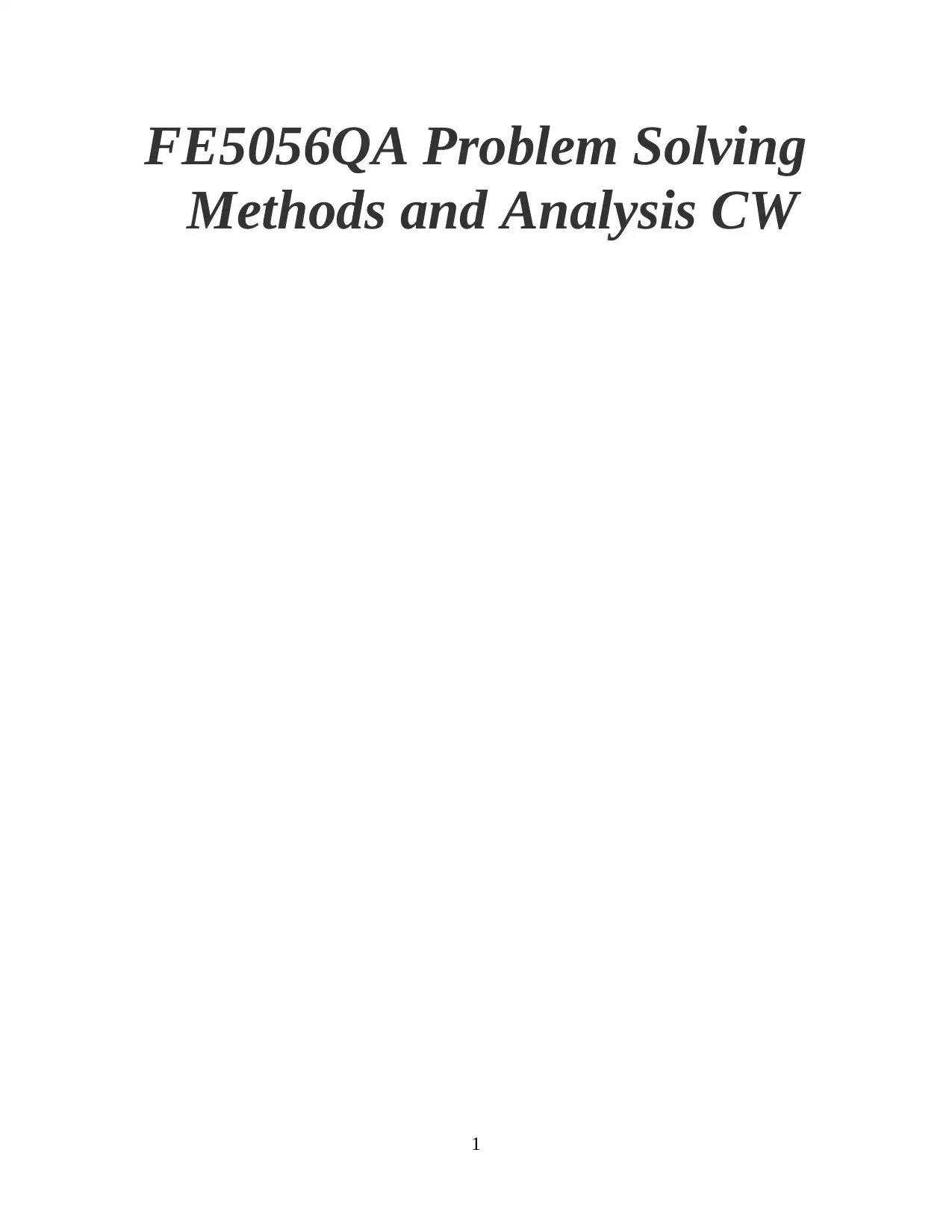
FE5056QA Problem Solving
Methods and Analysis CW
1
Methods and Analysis CW
1
Paraphrase This Document
Need a fresh take? Get an instant paraphrase of this document with our AI Paraphraser
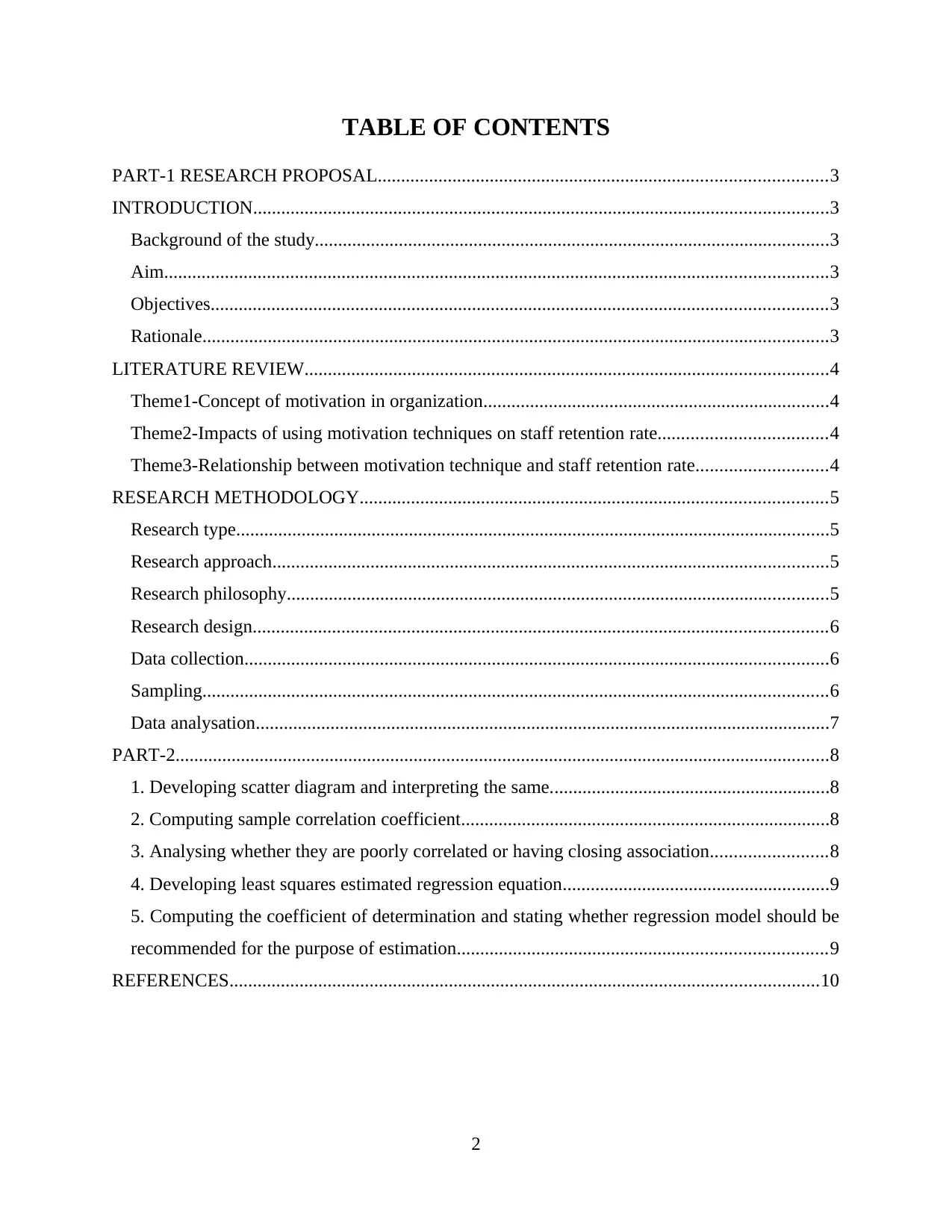
TABLE OF CONTENTS
PART-1 RESEARCH PROPOSAL................................................................................................3
INTRODUCTION...........................................................................................................................3
Background of the study..............................................................................................................3
Aim..............................................................................................................................................3
Objectives....................................................................................................................................3
Rationale......................................................................................................................................3
LITERATURE REVIEW................................................................................................................4
Theme1-Concept of motivation in organization..........................................................................4
Theme2-Impacts of using motivation techniques on staff retention rate....................................4
Theme3-Relationship between motivation technique and staff retention rate............................4
RESEARCH METHODOLOGY....................................................................................................5
Research type...............................................................................................................................5
Research approach.......................................................................................................................5
Research philosophy....................................................................................................................5
Research design...........................................................................................................................6
Data collection.............................................................................................................................6
Sampling......................................................................................................................................6
Data analysation...........................................................................................................................7
PART-2............................................................................................................................................8
1. Developing scatter diagram and interpreting the same............................................................8
2. Computing sample correlation coefficient...............................................................................8
3. Analysing whether they are poorly correlated or having closing association.........................8
4. Developing least squares estimated regression equation.........................................................9
5. Computing the coefficient of determination and stating whether regression model should be
recommended for the purpose of estimation...............................................................................9
REFERENCES..............................................................................................................................10
2
PART-1 RESEARCH PROPOSAL................................................................................................3
INTRODUCTION...........................................................................................................................3
Background of the study..............................................................................................................3
Aim..............................................................................................................................................3
Objectives....................................................................................................................................3
Rationale......................................................................................................................................3
LITERATURE REVIEW................................................................................................................4
Theme1-Concept of motivation in organization..........................................................................4
Theme2-Impacts of using motivation techniques on staff retention rate....................................4
Theme3-Relationship between motivation technique and staff retention rate............................4
RESEARCH METHODOLOGY....................................................................................................5
Research type...............................................................................................................................5
Research approach.......................................................................................................................5
Research philosophy....................................................................................................................5
Research design...........................................................................................................................6
Data collection.............................................................................................................................6
Sampling......................................................................................................................................6
Data analysation...........................................................................................................................7
PART-2............................................................................................................................................8
1. Developing scatter diagram and interpreting the same............................................................8
2. Computing sample correlation coefficient...............................................................................8
3. Analysing whether they are poorly correlated or having closing association.........................8
4. Developing least squares estimated regression equation.........................................................9
5. Computing the coefficient of determination and stating whether regression model should be
recommended for the purpose of estimation...............................................................................9
REFERENCES..............................................................................................................................10
2
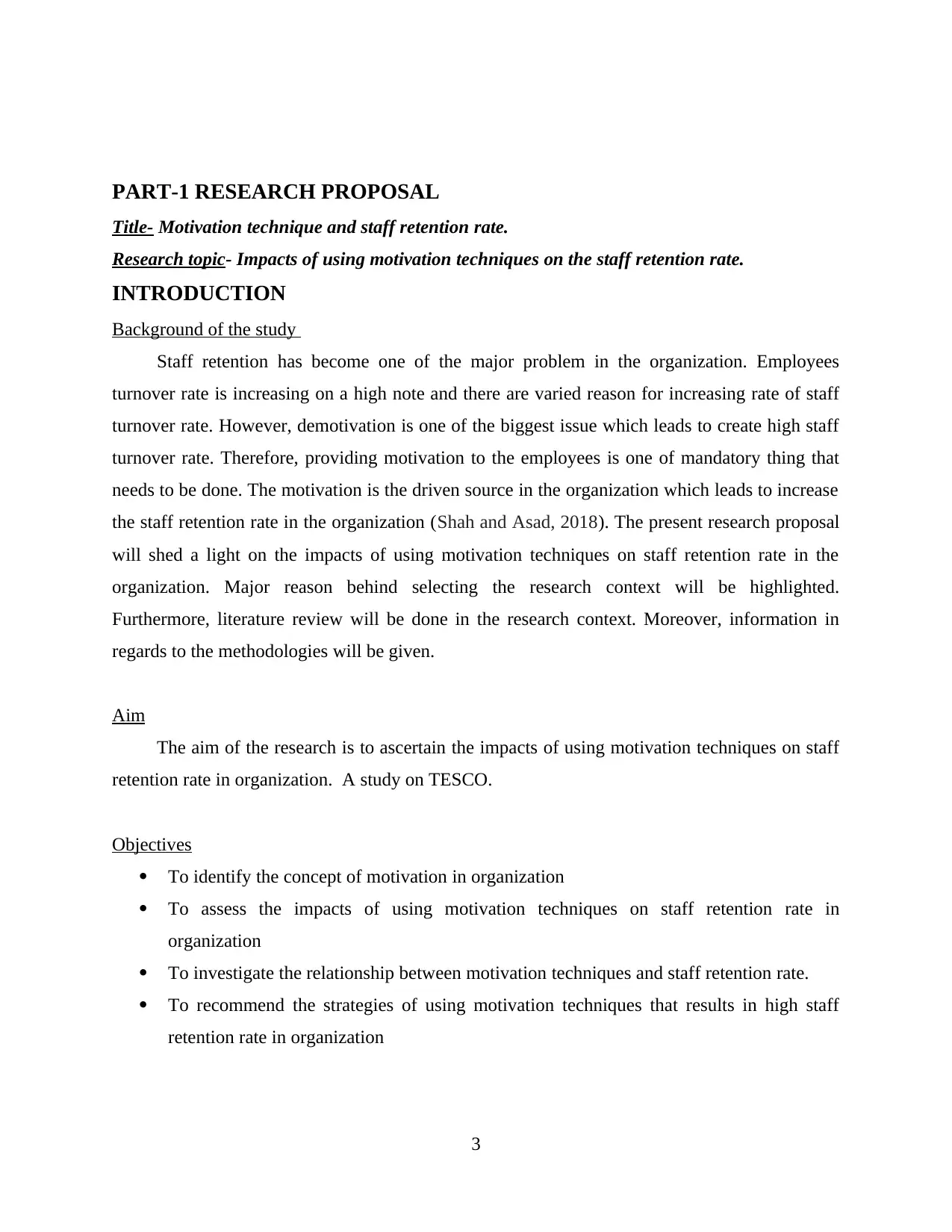
PART-1 RESEARCH PROPOSAL
Title- Motivation technique and staff retention rate.
Research topic- Impacts of using motivation techniques on the staff retention rate.
INTRODUCTION
Background of the study
Staff retention has become one of the major problem in the organization. Employees
turnover rate is increasing on a high note and there are varied reason for increasing rate of staff
turnover rate. However, demotivation is one of the biggest issue which leads to create high staff
turnover rate. Therefore, providing motivation to the employees is one of mandatory thing that
needs to be done. The motivation is the driven source in the organization which leads to increase
the staff retention rate in the organization (Shah and Asad, 2018). The present research proposal
will shed a light on the impacts of using motivation techniques on staff retention rate in the
organization. Major reason behind selecting the research context will be highlighted.
Furthermore, literature review will be done in the research context. Moreover, information in
regards to the methodologies will be given.
Aim
The aim of the research is to ascertain the impacts of using motivation techniques on staff
retention rate in organization. A study on TESCO.
Objectives
To identify the concept of motivation in organization
To assess the impacts of using motivation techniques on staff retention rate in
organization
To investigate the relationship between motivation techniques and staff retention rate.
To recommend the strategies of using motivation techniques that results in high staff
retention rate in organization
3
Title- Motivation technique and staff retention rate.
Research topic- Impacts of using motivation techniques on the staff retention rate.
INTRODUCTION
Background of the study
Staff retention has become one of the major problem in the organization. Employees
turnover rate is increasing on a high note and there are varied reason for increasing rate of staff
turnover rate. However, demotivation is one of the biggest issue which leads to create high staff
turnover rate. Therefore, providing motivation to the employees is one of mandatory thing that
needs to be done. The motivation is the driven source in the organization which leads to increase
the staff retention rate in the organization (Shah and Asad, 2018). The present research proposal
will shed a light on the impacts of using motivation techniques on staff retention rate in the
organization. Major reason behind selecting the research context will be highlighted.
Furthermore, literature review will be done in the research context. Moreover, information in
regards to the methodologies will be given.
Aim
The aim of the research is to ascertain the impacts of using motivation techniques on staff
retention rate in organization. A study on TESCO.
Objectives
To identify the concept of motivation in organization
To assess the impacts of using motivation techniques on staff retention rate in
organization
To investigate the relationship between motivation techniques and staff retention rate.
To recommend the strategies of using motivation techniques that results in high staff
retention rate in organization
3
⊘ This is a preview!⊘
Do you want full access?
Subscribe today to unlock all pages.

Trusted by 1+ million students worldwide
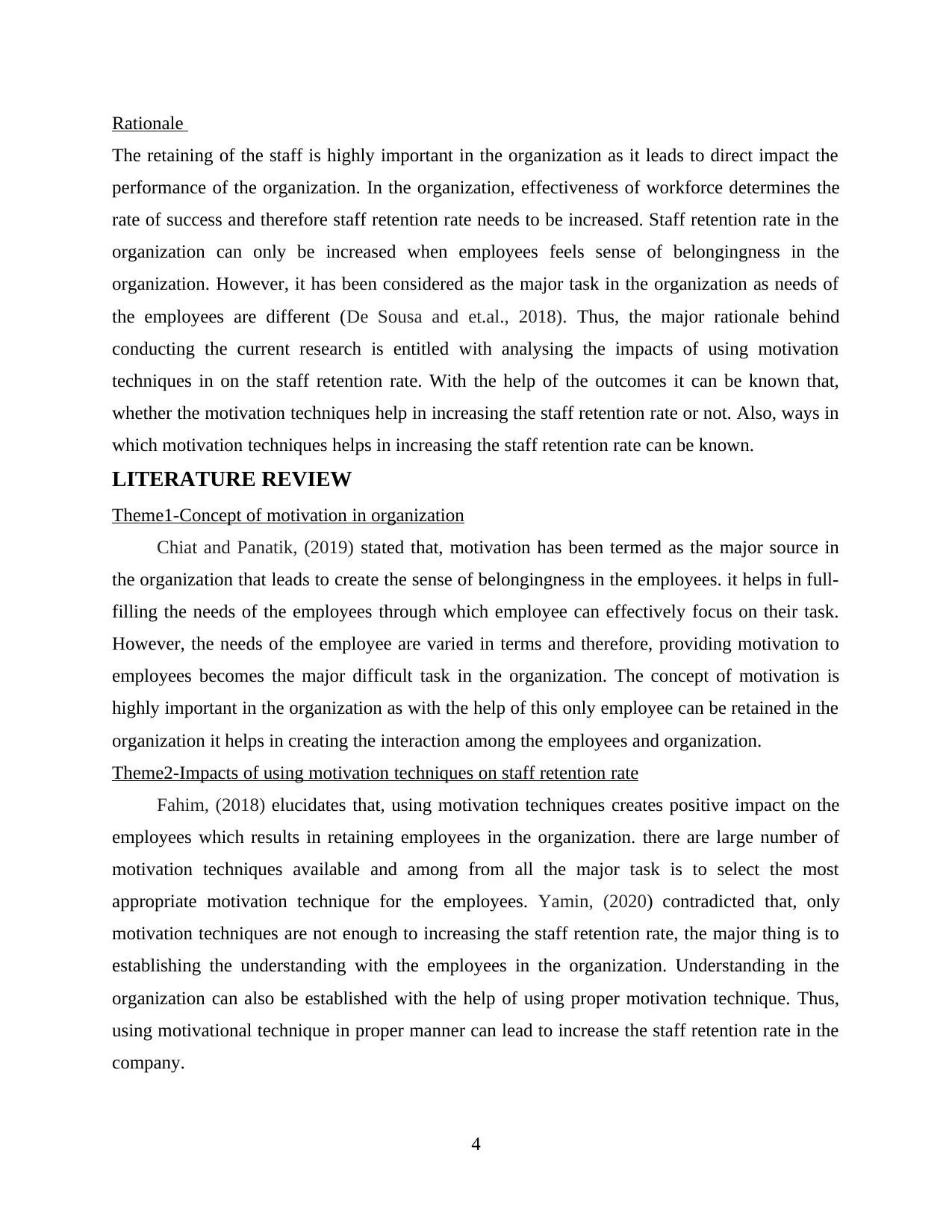
Rationale
The retaining of the staff is highly important in the organization as it leads to direct impact the
performance of the organization. In the organization, effectiveness of workforce determines the
rate of success and therefore staff retention rate needs to be increased. Staff retention rate in the
organization can only be increased when employees feels sense of belongingness in the
organization. However, it has been considered as the major task in the organization as needs of
the employees are different (De Sousa and et.al., 2018). Thus, the major rationale behind
conducting the current research is entitled with analysing the impacts of using motivation
techniques in on the staff retention rate. With the help of the outcomes it can be known that,
whether the motivation techniques help in increasing the staff retention rate or not. Also, ways in
which motivation techniques helps in increasing the staff retention rate can be known.
LITERATURE REVIEW
Theme1-Concept of motivation in organization
Chiat and Panatik, (2019) stated that, motivation has been termed as the major source in
the organization that leads to create the sense of belongingness in the employees. it helps in full-
filling the needs of the employees through which employee can effectively focus on their task.
However, the needs of the employee are varied in terms and therefore, providing motivation to
employees becomes the major difficult task in the organization. The concept of motivation is
highly important in the organization as with the help of this only employee can be retained in the
organization it helps in creating the interaction among the employees and organization.
Theme2-Impacts of using motivation techniques on staff retention rate
Fahim, (2018) elucidates that, using motivation techniques creates positive impact on the
employees which results in retaining employees in the organization. there are large number of
motivation techniques available and among from all the major task is to select the most
appropriate motivation technique for the employees. Yamin, (2020) contradicted that, only
motivation techniques are not enough to increasing the staff retention rate, the major thing is to
establishing the understanding with the employees in the organization. Understanding in the
organization can also be established with the help of using proper motivation technique. Thus,
using motivational technique in proper manner can lead to increase the staff retention rate in the
company.
4
The retaining of the staff is highly important in the organization as it leads to direct impact the
performance of the organization. In the organization, effectiveness of workforce determines the
rate of success and therefore staff retention rate needs to be increased. Staff retention rate in the
organization can only be increased when employees feels sense of belongingness in the
organization. However, it has been considered as the major task in the organization as needs of
the employees are different (De Sousa and et.al., 2018). Thus, the major rationale behind
conducting the current research is entitled with analysing the impacts of using motivation
techniques in on the staff retention rate. With the help of the outcomes it can be known that,
whether the motivation techniques help in increasing the staff retention rate or not. Also, ways in
which motivation techniques helps in increasing the staff retention rate can be known.
LITERATURE REVIEW
Theme1-Concept of motivation in organization
Chiat and Panatik, (2019) stated that, motivation has been termed as the major source in
the organization that leads to create the sense of belongingness in the employees. it helps in full-
filling the needs of the employees through which employee can effectively focus on their task.
However, the needs of the employee are varied in terms and therefore, providing motivation to
employees becomes the major difficult task in the organization. The concept of motivation is
highly important in the organization as with the help of this only employee can be retained in the
organization it helps in creating the interaction among the employees and organization.
Theme2-Impacts of using motivation techniques on staff retention rate
Fahim, (2018) elucidates that, using motivation techniques creates positive impact on the
employees which results in retaining employees in the organization. there are large number of
motivation techniques available and among from all the major task is to select the most
appropriate motivation technique for the employees. Yamin, (2020) contradicted that, only
motivation techniques are not enough to increasing the staff retention rate, the major thing is to
establishing the understanding with the employees in the organization. Understanding in the
organization can also be established with the help of using proper motivation technique. Thus,
using motivational technique in proper manner can lead to increase the staff retention rate in the
company.
4
Paraphrase This Document
Need a fresh take? Get an instant paraphrase of this document with our AI Paraphraser
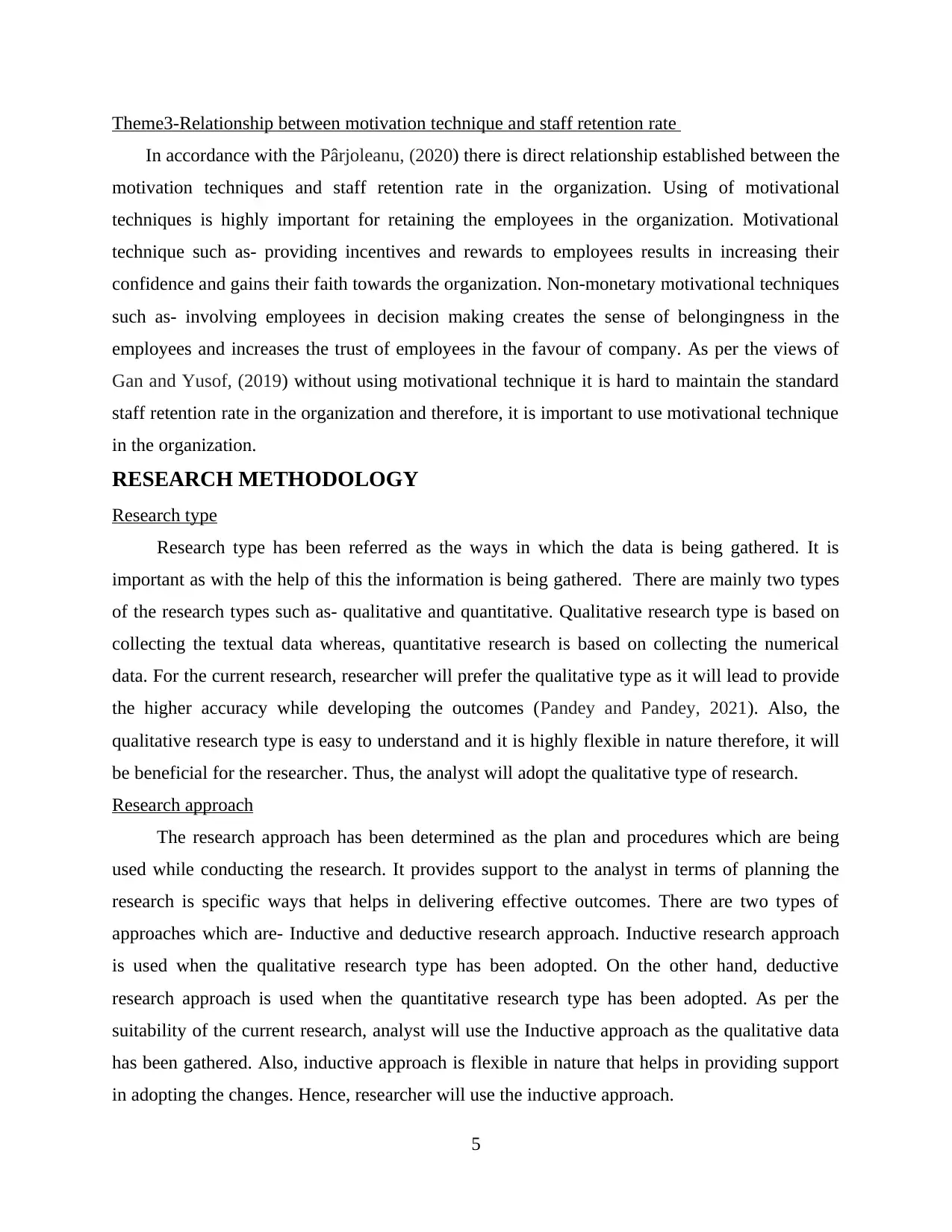
Theme3-Relationship between motivation technique and staff retention rate
In accordance with the Pârjoleanu, (2020) there is direct relationship established between the
motivation techniques and staff retention rate in the organization. Using of motivational
techniques is highly important for retaining the employees in the organization. Motivational
technique such as- providing incentives and rewards to employees results in increasing their
confidence and gains their faith towards the organization. Non-monetary motivational techniques
such as- involving employees in decision making creates the sense of belongingness in the
employees and increases the trust of employees in the favour of company. As per the views of
Gan and Yusof, (2019) without using motivational technique it is hard to maintain the standard
staff retention rate in the organization and therefore, it is important to use motivational technique
in the organization.
RESEARCH METHODOLOGY
Research type
Research type has been referred as the ways in which the data is being gathered. It is
important as with the help of this the information is being gathered. There are mainly two types
of the research types such as- qualitative and quantitative. Qualitative research type is based on
collecting the textual data whereas, quantitative research is based on collecting the numerical
data. For the current research, researcher will prefer the qualitative type as it will lead to provide
the higher accuracy while developing the outcomes (Pandey and Pandey, 2021). Also, the
qualitative research type is easy to understand and it is highly flexible in nature therefore, it will
be beneficial for the researcher. Thus, the analyst will adopt the qualitative type of research.
Research approach
The research approach has been determined as the plan and procedures which are being
used while conducting the research. It provides support to the analyst in terms of planning the
research is specific ways that helps in delivering effective outcomes. There are two types of
approaches which are- Inductive and deductive research approach. Inductive research approach
is used when the qualitative research type has been adopted. On the other hand, deductive
research approach is used when the quantitative research type has been adopted. As per the
suitability of the current research, analyst will use the Inductive approach as the qualitative data
has been gathered. Also, inductive approach is flexible in nature that helps in providing support
in adopting the changes. Hence, researcher will use the inductive approach.
5
In accordance with the Pârjoleanu, (2020) there is direct relationship established between the
motivation techniques and staff retention rate in the organization. Using of motivational
techniques is highly important for retaining the employees in the organization. Motivational
technique such as- providing incentives and rewards to employees results in increasing their
confidence and gains their faith towards the organization. Non-monetary motivational techniques
such as- involving employees in decision making creates the sense of belongingness in the
employees and increases the trust of employees in the favour of company. As per the views of
Gan and Yusof, (2019) without using motivational technique it is hard to maintain the standard
staff retention rate in the organization and therefore, it is important to use motivational technique
in the organization.
RESEARCH METHODOLOGY
Research type
Research type has been referred as the ways in which the data is being gathered. It is
important as with the help of this the information is being gathered. There are mainly two types
of the research types such as- qualitative and quantitative. Qualitative research type is based on
collecting the textual data whereas, quantitative research is based on collecting the numerical
data. For the current research, researcher will prefer the qualitative type as it will lead to provide
the higher accuracy while developing the outcomes (Pandey and Pandey, 2021). Also, the
qualitative research type is easy to understand and it is highly flexible in nature therefore, it will
be beneficial for the researcher. Thus, the analyst will adopt the qualitative type of research.
Research approach
The research approach has been determined as the plan and procedures which are being
used while conducting the research. It provides support to the analyst in terms of planning the
research is specific ways that helps in delivering effective outcomes. There are two types of
approaches which are- Inductive and deductive research approach. Inductive research approach
is used when the qualitative research type has been adopted. On the other hand, deductive
research approach is used when the quantitative research type has been adopted. As per the
suitability of the current research, analyst will use the Inductive approach as the qualitative data
has been gathered. Also, inductive approach is flexible in nature that helps in providing support
in adopting the changes. Hence, researcher will use the inductive approach.
5
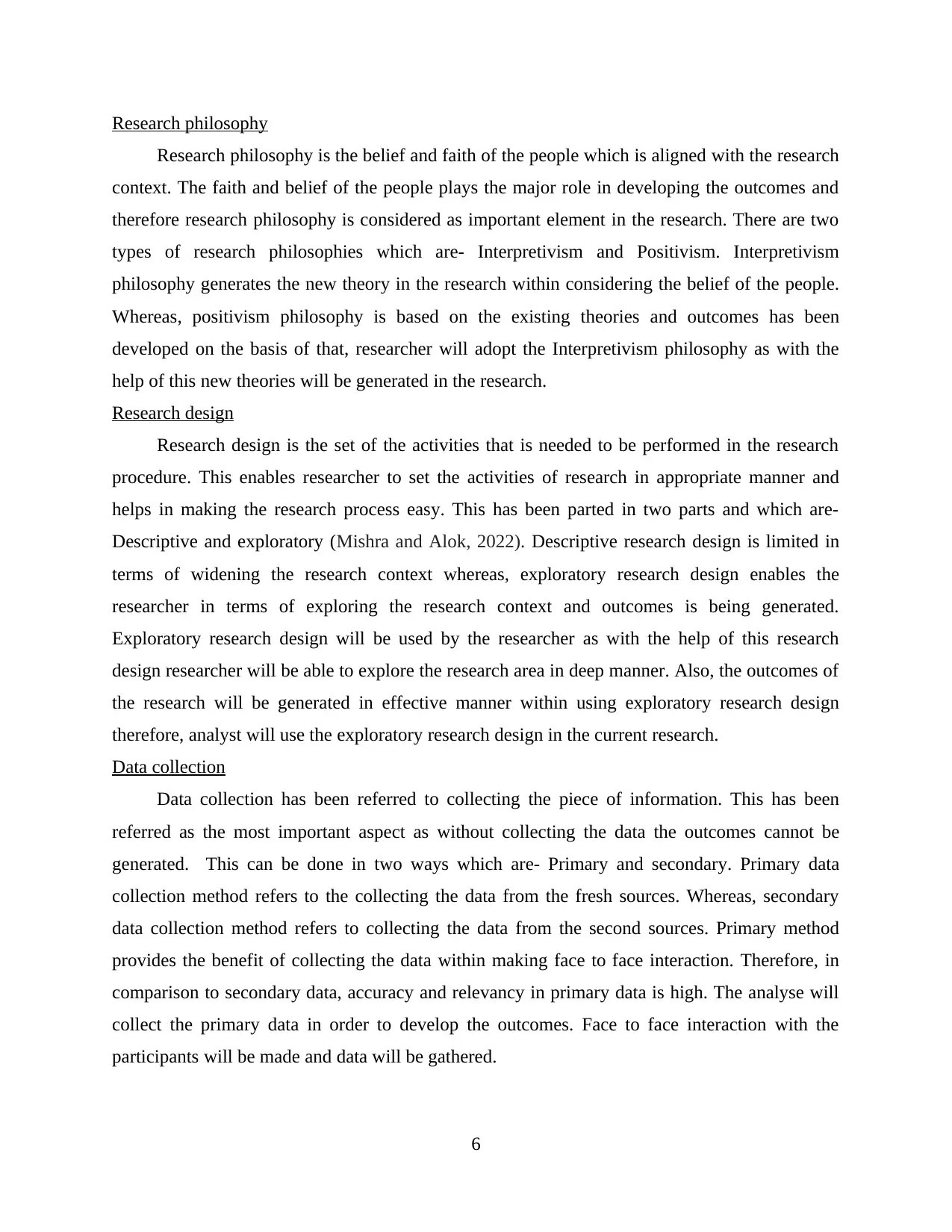
Research philosophy
Research philosophy is the belief and faith of the people which is aligned with the research
context. The faith and belief of the people plays the major role in developing the outcomes and
therefore research philosophy is considered as important element in the research. There are two
types of research philosophies which are- Interpretivism and Positivism. Interpretivism
philosophy generates the new theory in the research within considering the belief of the people.
Whereas, positivism philosophy is based on the existing theories and outcomes has been
developed on the basis of that, researcher will adopt the Interpretivism philosophy as with the
help of this new theories will be generated in the research.
Research design
Research design is the set of the activities that is needed to be performed in the research
procedure. This enables researcher to set the activities of research in appropriate manner and
helps in making the research process easy. This has been parted in two parts and which are-
Descriptive and exploratory (Mishra and Alok, 2022). Descriptive research design is limited in
terms of widening the research context whereas, exploratory research design enables the
researcher in terms of exploring the research context and outcomes is being generated.
Exploratory research design will be used by the researcher as with the help of this research
design researcher will be able to explore the research area in deep manner. Also, the outcomes of
the research will be generated in effective manner within using exploratory research design
therefore, analyst will use the exploratory research design in the current research.
Data collection
Data collection has been referred to collecting the piece of information. This has been
referred as the most important aspect as without collecting the data the outcomes cannot be
generated. This can be done in two ways which are- Primary and secondary. Primary data
collection method refers to the collecting the data from the fresh sources. Whereas, secondary
data collection method refers to collecting the data from the second sources. Primary method
provides the benefit of collecting the data within making face to face interaction. Therefore, in
comparison to secondary data, accuracy and relevancy in primary data is high. The analyse will
collect the primary data in order to develop the outcomes. Face to face interaction with the
participants will be made and data will be gathered.
6
Research philosophy is the belief and faith of the people which is aligned with the research
context. The faith and belief of the people plays the major role in developing the outcomes and
therefore research philosophy is considered as important element in the research. There are two
types of research philosophies which are- Interpretivism and Positivism. Interpretivism
philosophy generates the new theory in the research within considering the belief of the people.
Whereas, positivism philosophy is based on the existing theories and outcomes has been
developed on the basis of that, researcher will adopt the Interpretivism philosophy as with the
help of this new theories will be generated in the research.
Research design
Research design is the set of the activities that is needed to be performed in the research
procedure. This enables researcher to set the activities of research in appropriate manner and
helps in making the research process easy. This has been parted in two parts and which are-
Descriptive and exploratory (Mishra and Alok, 2022). Descriptive research design is limited in
terms of widening the research context whereas, exploratory research design enables the
researcher in terms of exploring the research context and outcomes is being generated.
Exploratory research design will be used by the researcher as with the help of this research
design researcher will be able to explore the research area in deep manner. Also, the outcomes of
the research will be generated in effective manner within using exploratory research design
therefore, analyst will use the exploratory research design in the current research.
Data collection
Data collection has been referred to collecting the piece of information. This has been
referred as the most important aspect as without collecting the data the outcomes cannot be
generated. This can be done in two ways which are- Primary and secondary. Primary data
collection method refers to the collecting the data from the fresh sources. Whereas, secondary
data collection method refers to collecting the data from the second sources. Primary method
provides the benefit of collecting the data within making face to face interaction. Therefore, in
comparison to secondary data, accuracy and relevancy in primary data is high. The analyse will
collect the primary data in order to develop the outcomes. Face to face interaction with the
participants will be made and data will be gathered.
6
⊘ This is a preview!⊘
Do you want full access?
Subscribe today to unlock all pages.

Trusted by 1+ million students worldwide
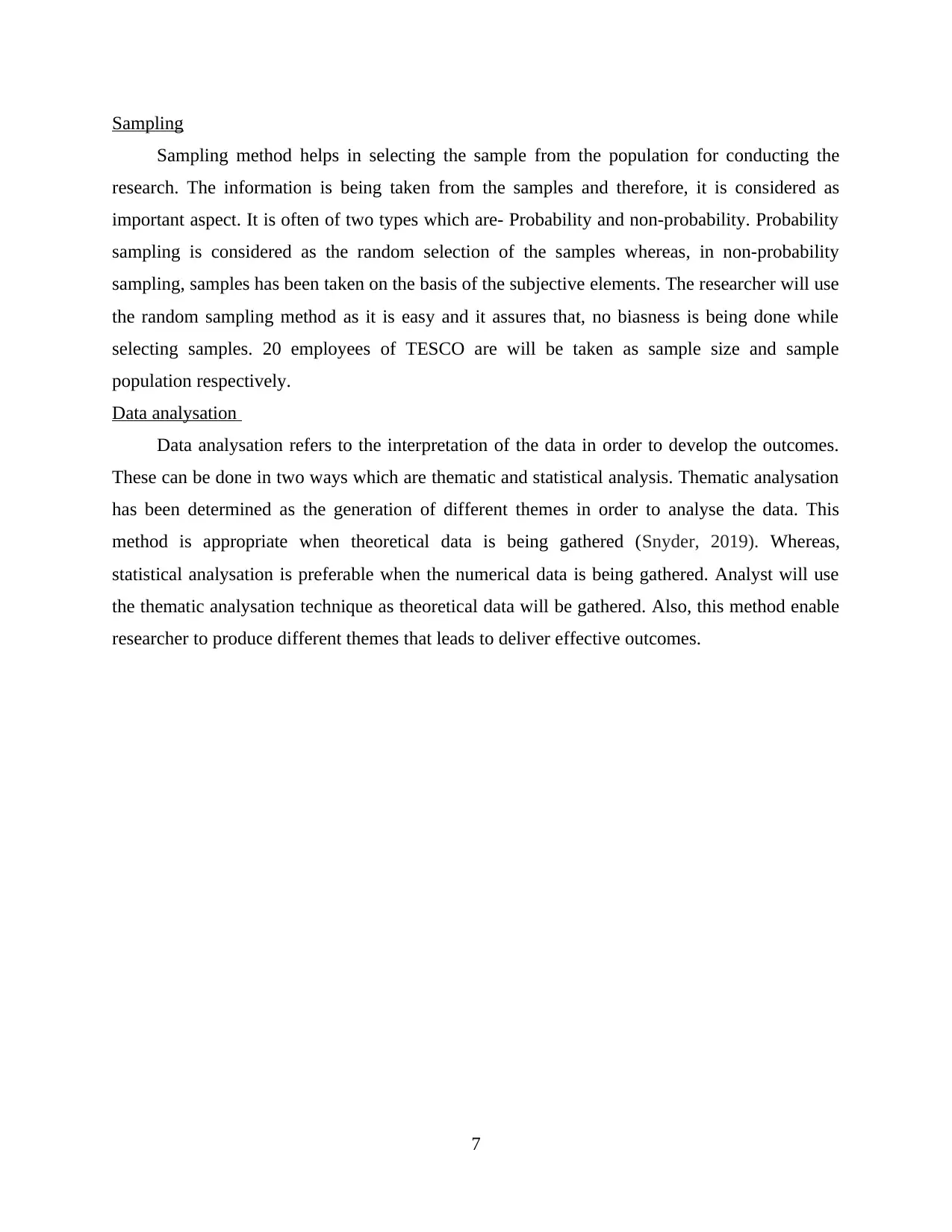
Sampling
Sampling method helps in selecting the sample from the population for conducting the
research. The information is being taken from the samples and therefore, it is considered as
important aspect. It is often of two types which are- Probability and non-probability. Probability
sampling is considered as the random selection of the samples whereas, in non-probability
sampling, samples has been taken on the basis of the subjective elements. The researcher will use
the random sampling method as it is easy and it assures that, no biasness is being done while
selecting samples. 20 employees of TESCO are will be taken as sample size and sample
population respectively.
Data analysation
Data analysation refers to the interpretation of the data in order to develop the outcomes.
These can be done in two ways which are thematic and statistical analysis. Thematic analysation
has been determined as the generation of different themes in order to analyse the data. This
method is appropriate when theoretical data is being gathered (Snyder, 2019). Whereas,
statistical analysation is preferable when the numerical data is being gathered. Analyst will use
the thematic analysation technique as theoretical data will be gathered. Also, this method enable
researcher to produce different themes that leads to deliver effective outcomes.
7
Sampling method helps in selecting the sample from the population for conducting the
research. The information is being taken from the samples and therefore, it is considered as
important aspect. It is often of two types which are- Probability and non-probability. Probability
sampling is considered as the random selection of the samples whereas, in non-probability
sampling, samples has been taken on the basis of the subjective elements. The researcher will use
the random sampling method as it is easy and it assures that, no biasness is being done while
selecting samples. 20 employees of TESCO are will be taken as sample size and sample
population respectively.
Data analysation
Data analysation refers to the interpretation of the data in order to develop the outcomes.
These can be done in two ways which are thematic and statistical analysis. Thematic analysation
has been determined as the generation of different themes in order to analyse the data. This
method is appropriate when theoretical data is being gathered (Snyder, 2019). Whereas,
statistical analysation is preferable when the numerical data is being gathered. Analyst will use
the thematic analysation technique as theoretical data will be gathered. Also, this method enable
researcher to produce different themes that leads to deliver effective outcomes.
7
Paraphrase This Document
Need a fresh take? Get an instant paraphrase of this document with our AI Paraphraser
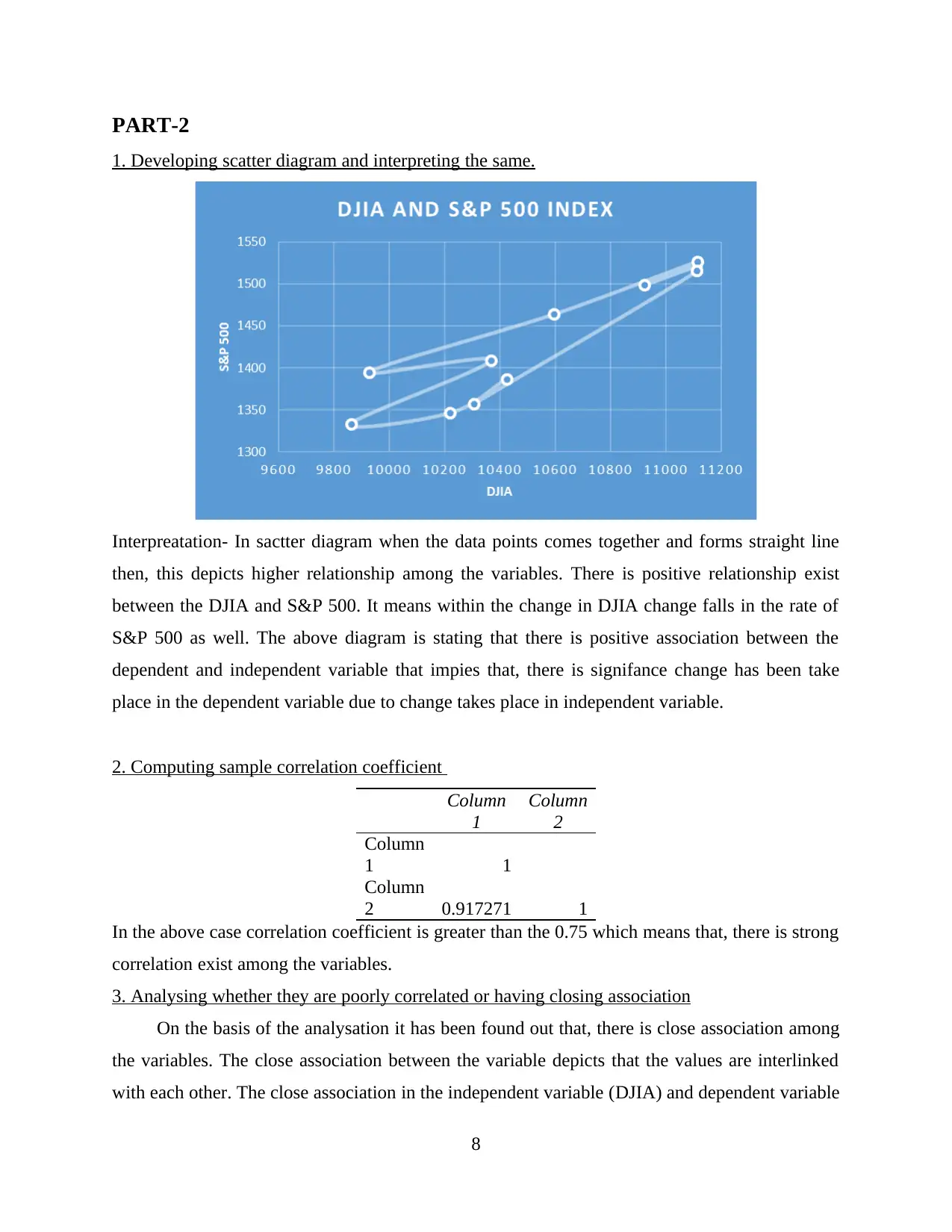
PART-2
1. Developing scatter diagram and interpreting the same.
Interpreatation- In sactter diagram when the data points comes together and forms straight line
then, this depicts higher relationship among the variables. There is positive relationship exist
between the DJIA and S&P 500. It means within the change in DJIA change falls in the rate of
S&P 500 as well. The above diagram is stating that there is positive association between the
dependent and independent variable that impies that, there is signifance change has been take
place in the dependent variable due to change takes place in independent variable.
2. Computing sample correlation coefficient
Column
1
Column
2
Column
1 1
Column
2 0.917271 1
In the above case correlation coefficient is greater than the 0.75 which means that, there is strong
correlation exist among the variables.
3. Analysing whether they are poorly correlated or having closing association
On the basis of the analysation it has been found out that, there is close association among
the variables. The close association between the variable depicts that the values are interlinked
with each other. The close association in the independent variable (DJIA) and dependent variable
8
1. Developing scatter diagram and interpreting the same.
Interpreatation- In sactter diagram when the data points comes together and forms straight line
then, this depicts higher relationship among the variables. There is positive relationship exist
between the DJIA and S&P 500. It means within the change in DJIA change falls in the rate of
S&P 500 as well. The above diagram is stating that there is positive association between the
dependent and independent variable that impies that, there is signifance change has been take
place in the dependent variable due to change takes place in independent variable.
2. Computing sample correlation coefficient
Column
1
Column
2
Column
1 1
Column
2 0.917271 1
In the above case correlation coefficient is greater than the 0.75 which means that, there is strong
correlation exist among the variables.
3. Analysing whether they are poorly correlated or having closing association
On the basis of the analysation it has been found out that, there is close association among
the variables. The close association between the variable depicts that the values are interlinked
with each other. The close association in the independent variable (DJIA) and dependent variable
8
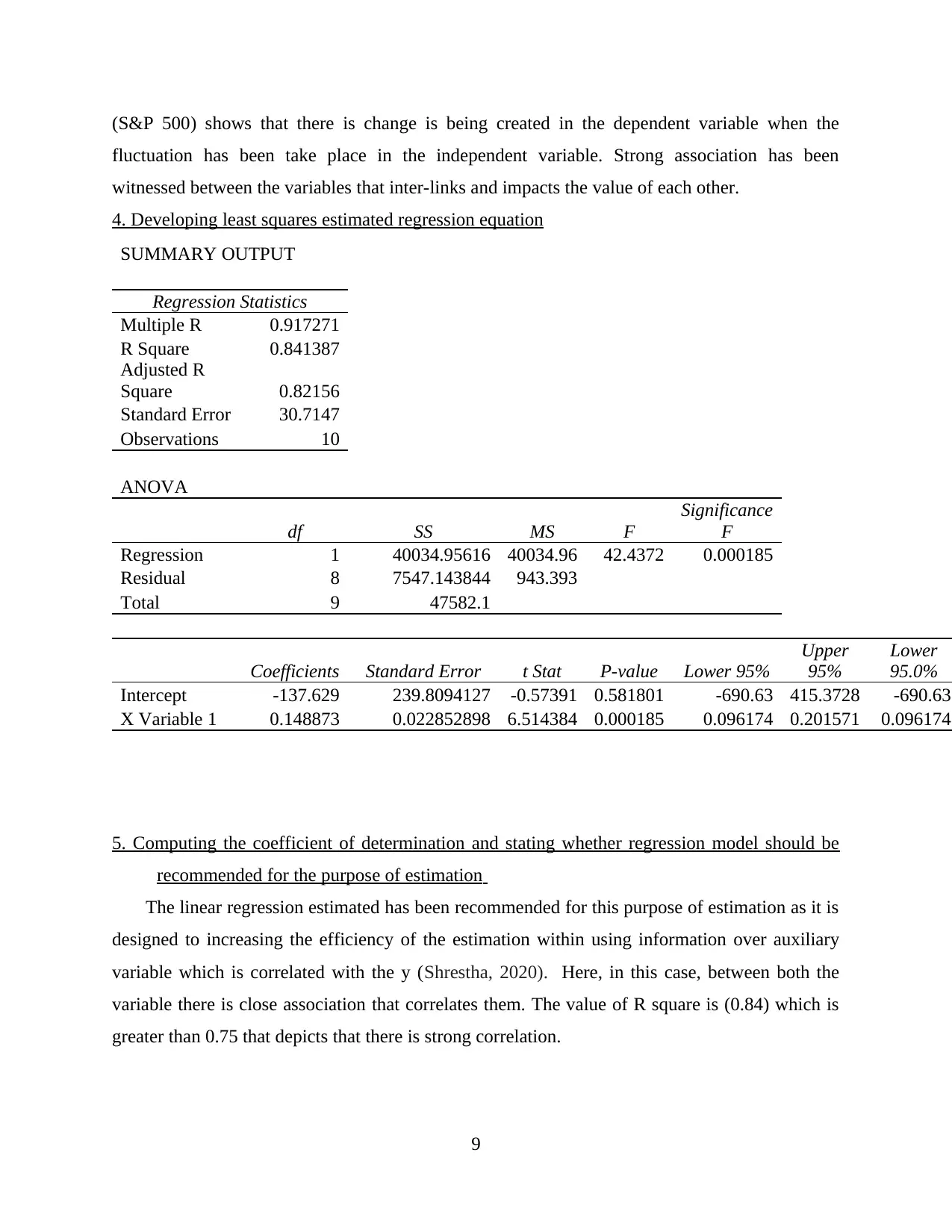
(S&P 500) shows that there is change is being created in the dependent variable when the
fluctuation has been take place in the independent variable. Strong association has been
witnessed between the variables that inter-links and impacts the value of each other.
4. Developing least squares estimated regression equation
SUMMARY OUTPUT
Regression Statistics
Multiple R 0.917271
R Square 0.841387
Adjusted R
Square 0.82156
Standard Error 30.7147
Observations 10
ANOVA
df SS MS F
Significance
F
Regression 1 40034.95616 40034.96 42.4372 0.000185
Residual 8 7547.143844 943.393
Total 9 47582.1
Coefficients Standard Error t Stat P-value Lower 95%
Upper
95%
Lower
95.0%
Intercept -137.629 239.8094127 -0.57391 0.581801 -690.63 415.3728 -690.63
X Variable 1 0.148873 0.022852898 6.514384 0.000185 0.096174 0.201571 0.096174
5. Computing the coefficient of determination and stating whether regression model should be
recommended for the purpose of estimation
The linear regression estimated has been recommended for this purpose of estimation as it is
designed to increasing the efficiency of the estimation within using information over auxiliary
variable which is correlated with the y (Shrestha, 2020). Here, in this case, between both the
variable there is close association that correlates them. The value of R square is (0.84) which is
greater than 0.75 that depicts that there is strong correlation.
9
fluctuation has been take place in the independent variable. Strong association has been
witnessed between the variables that inter-links and impacts the value of each other.
4. Developing least squares estimated regression equation
SUMMARY OUTPUT
Regression Statistics
Multiple R 0.917271
R Square 0.841387
Adjusted R
Square 0.82156
Standard Error 30.7147
Observations 10
ANOVA
df SS MS F
Significance
F
Regression 1 40034.95616 40034.96 42.4372 0.000185
Residual 8 7547.143844 943.393
Total 9 47582.1
Coefficients Standard Error t Stat P-value Lower 95%
Upper
95%
Lower
95.0%
Intercept -137.629 239.8094127 -0.57391 0.581801 -690.63 415.3728 -690.63
X Variable 1 0.148873 0.022852898 6.514384 0.000185 0.096174 0.201571 0.096174
5. Computing the coefficient of determination and stating whether regression model should be
recommended for the purpose of estimation
The linear regression estimated has been recommended for this purpose of estimation as it is
designed to increasing the efficiency of the estimation within using information over auxiliary
variable which is correlated with the y (Shrestha, 2020). Here, in this case, between both the
variable there is close association that correlates them. The value of R square is (0.84) which is
greater than 0.75 that depicts that there is strong correlation.
9
⊘ This is a preview!⊘
Do you want full access?
Subscribe today to unlock all pages.

Trusted by 1+ million students worldwide
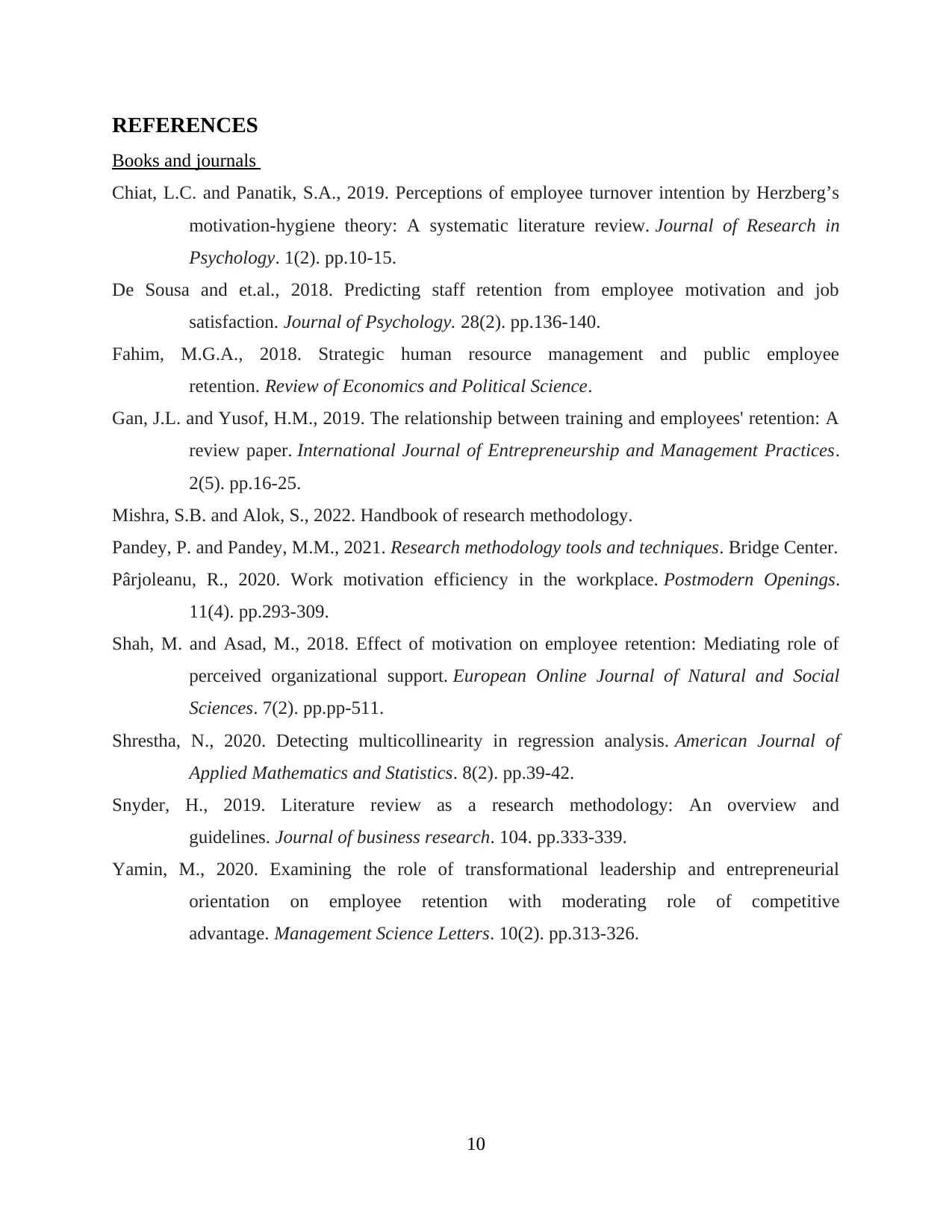
REFERENCES
Books and journals
Chiat, L.C. and Panatik, S.A., 2019. Perceptions of employee turnover intention by Herzberg’s
motivation-hygiene theory: A systematic literature review. Journal of Research in
Psychology. 1(2). pp.10-15.
De Sousa and et.al., 2018. Predicting staff retention from employee motivation and job
satisfaction. Journal of Psychology. 28(2). pp.136-140.
Fahim, M.G.A., 2018. Strategic human resource management and public employee
retention. Review of Economics and Political Science.
Gan, J.L. and Yusof, H.M., 2019. The relationship between training and employees' retention: A
review paper. International Journal of Entrepreneurship and Management Practices.
2(5). pp.16-25.
Mishra, S.B. and Alok, S., 2022. Handbook of research methodology.
Pandey, P. and Pandey, M.M., 2021. Research methodology tools and techniques. Bridge Center.
Pârjoleanu, R., 2020. Work motivation efficiency in the workplace. Postmodern Openings.
11(4). pp.293-309.
Shah, M. and Asad, M., 2018. Effect of motivation on employee retention: Mediating role of
perceived organizational support. European Online Journal of Natural and Social
Sciences. 7(2). pp.pp-511.
Shrestha, N., 2020. Detecting multicollinearity in regression analysis. American Journal of
Applied Mathematics and Statistics. 8(2). pp.39-42.
Snyder, H., 2019. Literature review as a research methodology: An overview and
guidelines. Journal of business research. 104. pp.333-339.
Yamin, M., 2020. Examining the role of transformational leadership and entrepreneurial
orientation on employee retention with moderating role of competitive
advantage. Management Science Letters. 10(2). pp.313-326.
10
Books and journals
Chiat, L.C. and Panatik, S.A., 2019. Perceptions of employee turnover intention by Herzberg’s
motivation-hygiene theory: A systematic literature review. Journal of Research in
Psychology. 1(2). pp.10-15.
De Sousa and et.al., 2018. Predicting staff retention from employee motivation and job
satisfaction. Journal of Psychology. 28(2). pp.136-140.
Fahim, M.G.A., 2018. Strategic human resource management and public employee
retention. Review of Economics and Political Science.
Gan, J.L. and Yusof, H.M., 2019. The relationship between training and employees' retention: A
review paper. International Journal of Entrepreneurship and Management Practices.
2(5). pp.16-25.
Mishra, S.B. and Alok, S., 2022. Handbook of research methodology.
Pandey, P. and Pandey, M.M., 2021. Research methodology tools and techniques. Bridge Center.
Pârjoleanu, R., 2020. Work motivation efficiency in the workplace. Postmodern Openings.
11(4). pp.293-309.
Shah, M. and Asad, M., 2018. Effect of motivation on employee retention: Mediating role of
perceived organizational support. European Online Journal of Natural and Social
Sciences. 7(2). pp.pp-511.
Shrestha, N., 2020. Detecting multicollinearity in regression analysis. American Journal of
Applied Mathematics and Statistics. 8(2). pp.39-42.
Snyder, H., 2019. Literature review as a research methodology: An overview and
guidelines. Journal of business research. 104. pp.333-339.
Yamin, M., 2020. Examining the role of transformational leadership and entrepreneurial
orientation on employee retention with moderating role of competitive
advantage. Management Science Letters. 10(2). pp.313-326.
10
1 out of 10
Related Documents
Your All-in-One AI-Powered Toolkit for Academic Success.
+13062052269
info@desklib.com
Available 24*7 on WhatsApp / Email
![[object Object]](/_next/static/media/star-bottom.7253800d.svg)
Unlock your academic potential
Copyright © 2020–2025 A2Z Services. All Rights Reserved. Developed and managed by ZUCOL.





